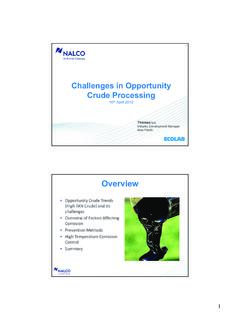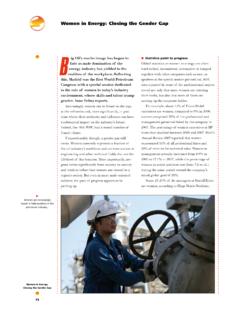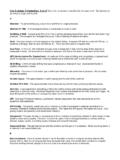Transcription of Enhanced oil recovery: challenges & opportunities
1 recovery is at the heart of oil production from underground reservoirs. If the average worldwide recovery factor from hydrocarbon reservoirs can be increased beyond current limits, it will alleviate a number of issues related to global energy supply. Currently the daily oil production comes from mature or maturing oil fields and reserves replacement is not keeping pace with the growing energy demand. The world average recovery factor from hydrocarbon reservoirs is stuck in the mid-30 per cent range. This challenge becomes an opportunity for advanced secondary and Enhanced oil recovery (EOR) technologies that may mitigate the demand-supply paper presents a big-picture overview of EOR technologies with the focus on challenges and opportunities .
2 The implementation of EOR is intimately tied to the price of oil and overall economics. EOR is capital and resource intensive, and expensive, primarily due to high injectant costs. The timing of EOR is also important: a case is made that advanced secondary recovery (improved oil recovery or IOR) technologies are a better first option before full-field deployment of EOR. Realisation of EOR potential can only be achieved through long-term commitments, both in capital and human resources, a vision to strive towards ultimate oil recovery instead of immediate oil recovery , research and development, and a willingness to take risks. While EOR technologies have grown over the years, significant challenges remain. Some of the enablers for EOR are also discussed in this definitionsAt this stage, it is important to define EOR.
3 There is a lot of confusion around the usage of the terms EOR and IOR. Figure 1 shows these in terms of oil recovery , as defined by the Society of Petroleum Engineers (SPE)1,2. Primary and secondary recovery (conventional recovery ) targets mobile oil in the reservoir and tertiary recovery or EOR targets immobile oil (that oil which cannot be produced due to capillary and viscous forces).Primary, secondary and tertiary (EOR) recovery methods follow a natural progression of oil production from the start to a point where it is no longer economical to produce from the hydrocarbon reservoir. EOR processes attempt to recover oil beyond secondary methods, or what is left. recovery , especially EOR, is closely associated with the price of oil and overall economics.
4 On average, the worldwide recovery factor from conventional (primary and secondary) recovery methods is about a third of what was originally present in the reservoir. This implies that the target for EOR is substantial ( / of the resource base). Improving the recovery factor can be achieved by deploying advanced IOR technologies using best-in-class reservoir management practices, and EOR technologies. Worldwide EOR oil productionThe total world oil production from EOR has remained relatively level over the years, contributing about 3 million barrels of oil per day (Figure 2), compared to ~85 million barrels of daily production, or about per cent of the daily production. The bulk of this production is from thermal methods contributing ~2 million barrels of oil per day.
5 This includes the Canadian heavy oil (Alberta), California (Bakersfield), Venezuela, Indonesia, Oman, China and others. CO2-EOR, which has been on the rise lately contributes about a third of a million barrels of oil per day, mostly from the Permian Basin in the US and the Weyburn field in Canada. Hydrocarbon gas injection contributes another one third of a million barrels per day from projects in Venezuela, 64 World Petroleum Council: Official Publication 2010 Enhanced oil recovery : challenges & opportunities BY SUNIL KOKAL AND ABDULAZIZ AL-KAABIEXPEC ADVANCED RESEARCH CENTRE, SAUDI ARAMCOENVIRONMENT AND SUSTAINABILITYF igure 1: EOR/IOR definitionFigure 2: Worldwide EOR production rates2000 1500 1000 500 0 Production (KB/d)Number of Projects Worldwide>100<5>100<5<25 Thermal Chemical HC Gas CO2 Others(Data from Oil & Gas Journal, SPE, and other sources)the US (mostly Alaska), Canada and Libya.
6 Hydrocarbon gas injection is mostly implemented where the gas supply cannot be monetised. Production from chemical EOR is practically all from China with the total worldwide production of another third of a million barrels per day. Other more esoteric methods, like microbial have only been field-tested without any significant quantities being produced on a commercial numbers were taken from the SPE literature, Oil and Gas Journal3 and other sources, and probably are a little conservative because some of the projects are not reported, especially the new ones. A better estimate of the total EOR production will be about 10-20 per cent higher than the 3 million per day figure quoted current statusThe global average or aggregate recovery factor from oil reservoirs is about a third.
7 This is considered low and leaves a substantial amount of oil underground. A global effort has been under way for some time to increase this number and one reason for its failure is the relationship between oil price and resource availability. Figure 3, from the International Energy Agency, shows the connection between production cost and oil resources and the cost of converting them to reserves. The cheapest injectant for producing oil is water. As long as companies can produce oil by injecting water, they will continue to do so. Another ~2 trillion barrels of oil can be produced with the price of oil below US$40 (2008 $) per barrel. Many of the EOR technologies kick in when the price of oil is between US$20-80 per barrel. In the early 1980s there was tremendous interest generated in EOR due to oil price escalation.
8 The number of EOR projects and R&D investment peaked in 1986. The interest fizzled out in the 1990s and early 2000s with a collapse in the price of oil. A renewed and growing interest has taken hold during the past 5 years as the price of oil has increased again. Figure 4 shows this relationship between EOR projects and oil price. There is a lag between the price of oil and EOR projects. In the last price escalation, interest was mostly in the US but this time the interest in EOR projects is the link of EOR to oil price, the projects are generally complex, technology-heavy and require considerable capital investment and financial risks. The risks are aggravated with the fluctuations in the price of oil. The unit costs of EOR oil are substantially higher than those of secondary or conventional oil.
9 Another challenge for EOR projects is the long lead time required for such projects. Typically, it may take several decades from the start of the concept generating laboratory data and conducting simulation studies to the first pilot and finally, full commercialisation. Two examples are given here, one each for thermal (Figure 5) and miscible gas injection (Figure 6) projects. While there has been some discussion in the literature of applying or deploying EOR at an early stage of a reservoir s life, this is generally difficult, and not necessarily the best option, due to the risks involved and lack of data availability, that can easily be obtained during the secondary stage of two most popular EOR methods as discussed below are thermal (steam) and miscible gas injection , which are mature technologies.
10 In chemical EOR, polymer injection is reaching commercial status (Figure 7). Acid gas injection , in-situ combustion (including the newer high-pressure air injection , (HPAI)) and combination chemical flooding are still in the technology development stage. Microbial, hybrid and other novel technologies are in the R&D stage. This compounds and restricts the application of EOR for a given field. If thermal and miscible gas injection methods are applicable to a given reservoir, then the decision to move forward is a little easier. If not, the decision is harder, and depends on the availability of injectant, economics and other factors previously technology matrixEOR methods are classified by the main mechanism of oil displacement4-9. There are really just three basic mechanisms for recovering oil from rock other than by water alone.












